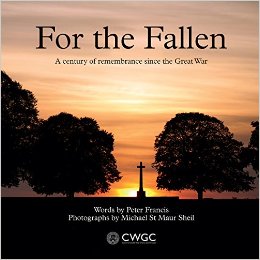We are inching close to Armistice Day and the poppies will soon be on sale again. Like tens of thousands of others I wear mine with pride. In a recent review on a Great War battlefields book I recounted my connection to the war and how it had expanded with the discovery of my Uncle Les’ dead man’s penny – the so called Death Plaque issued by His Majesty’s Government in gratitude to the widows and bereft mothers of Britain for their loss. Then, as now, it doesn’t seem like much to show for the death of a son or husband. Some families received more than one.
I have a neighbour, now sadly ailing with an incurable disease, who spent years clearing houses and working in the salvage game. He built up quite a collection of Death Plaques – just something else to be abandoned when the elderly passed on and their treasures of yesterday became tomorrow’s junk. I occasionally wonder what will happen to them when my neighbour himself moves on.
Each of these plaques represents a person. They were not anonymous – they lived and breathed and called somewhere home. You can picture them in lines from John McCrae’s verse, or maybe you prefer Binyon or even Sassoon or Owen. They were flesh and blood. These reflections can get you some way into the mind set of Fabian Ware, one of the greatest men of the 20th Century who isn’t on stamps or banknotes, nor is he cast in bronze or chiselled from stone. His monument is the modern day Commonwealth War Graves Commission.
This quite magnificent book from the CWGC shows the epic result of Fabian Ware and his staff’s work in the wake of the First World War.
It doesn’t seem that long ago since the Commission published Remembered – an awesome work outlining how the CWGC has grown and the way it works, cemented by a stunning collection of photographs that propelled me from Railway Hollow on the Somme to Sai Wan on Hong Kong island. I didn’t set out to mimic the photography, but I HAD to see the places and record them in my own way. The work goes on.
That spirit is repeated here in the words and photography of Peter Francis and Michael St MaurSheil. I have lookedrepeatedly through this book since it fell on my doormat and I am still bedazzled by it. There have been occasions when I have claimed some books are virtually unreviewable. This is one of them. What can I say that will make a difference to how it sells or how it is received? I have seen write-ups in the British press and they all seem to follow a similar path of gentle awe. All I can add is you really need a copy of your own. If this book doesn’t confirm the simple perfection of battlefield pilgrimages then I don’t know what will.
The photography is out of this world. The collection includes so many places familiar to me and I am impressed at the very different perspectives the photographer found. I like to tell myself, and this isn’t unreasonable, that my often quick visits to a particular site do not compare with having the time to ponder the photography or the use of cherry-pickers and ladders…or whatever the actual method. My point is, this is no point and shoot exercise – it was built with a great degree of care.
To me the ultimate point remains that these cemeteries and memorials are not just tourism attractions for bucket listers or the tea and a wee brigade the young guardians of Newfoundland Memorial Park will recognise. They are sacred. In Gallipoli I stood at Ari Burnu, Lone Pine and The Nek in the knowledge that the dead can be the foundation of a national spirit that transcends their meaning to family and friends alone. On Hill 10 at Suvla I listened to a recording of a tearful old Lancastrian recalling lost faces from his youth while singing a song they all knew – Homeland, homeland, when will I see you again? When he unveiled the Menin Gate in 1927, Lord Plumer affirmed – They are not missing, they are here.
I will take thousands more photos on the Western Front and beyond before I call it a day. I don’t claim they will match the perspectives in this book, but I have been inspired. It isn’t the first time and it won’t be the last. This book isn’t the CWGC blowing their own trumpet it is more like a statement of accounts. The books have been balanced.
Making art from war cemeteries might seem like an odd thing to do at first glance but it is in itself life affirming. An act the British Empire’s nigh on a million dead of the Great War would surely approve of.
I come back, again, to St Mark – My Name is Legion: For we are many.Sir
Fabian Ware didn’t forget any of them.
Reviewed by Mark Barnes for War History Online.
FOR THE FALLEN
A Century of Remembrance Since the Great War
Words by Peter Francis and photography by Michael St MaurSheil
Produced for the CWGC by AA Publishing
ISBN: 978-0-7495-7647-9
